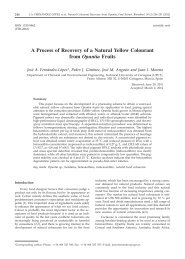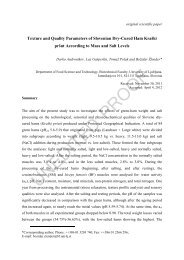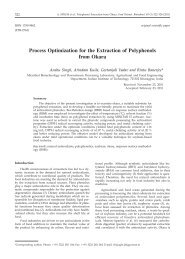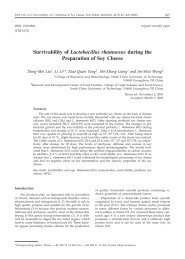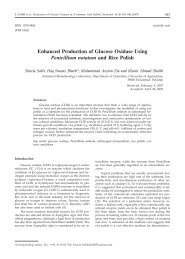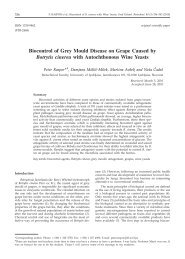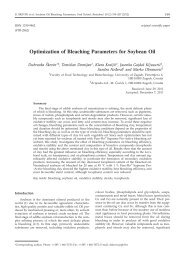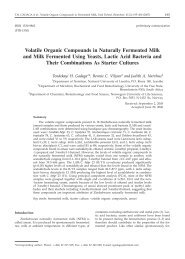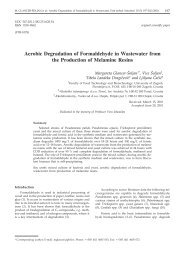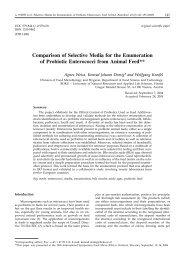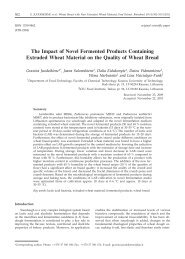a-Amylase Production by Bacillus amyloliquefaciens Using Agro ...
a-Amylase Production by Bacillus amyloliquefaciens Using Agro ...
a-Amylase Production by Bacillus amyloliquefaciens Using Agro ...
You also want an ePaper? Increase the reach of your titles
YUMPU automatically turns print PDFs into web optimized ePapers that Google loves.
D. GANGADHARAN et al.: a-<strong>Amylase</strong> Produced <strong>by</strong> B. <strong>amyloliquefaciens</strong>, Food Technol. Biotechnol. 49 (3) 336–340 (2011)<br />
conditions during fermentation in bioreactors are agitation<br />
and mixing. Agitation is important for adequate mixing,<br />
mass transfer and heat transfer. It is beneficial to the<br />
growth and performance of microbial cells <strong>by</strong> improving<br />
the mass transfer characteristics with respect to substrate<br />
and product/<strong>by</strong>-product (5). Multiple impellers on a<br />
single shaft with appropriate combination and spacing<br />
have been suggested as optimum. In such cases, mixing<br />
and mass transfer are dependent on the gas flow rate,<br />
type of agitator, its speed and the properties of liquids.<br />
Power consumption per impeller decreases with an increase<br />
in the number of impellers and this increases the<br />
uniformity of energy dissipation (6). The dissolved oxygen<br />
(DO) concentration becomes a limiting nutrient in<br />
the processes of high oxygen demand (7). The supply of<br />
oxygen can be the controlling step in industrial bioprocesses<br />
and in the scale-up of aerobic biosynthesis systems<br />
(8–10). The oxygen transfer rate could be affected<br />
<strong>by</strong> several factors, such as geometry and characteristics<br />
of the vessels, liquid properties (viscosity, superficial tension,<br />
etc.), the dissipated energy in the fluid, biocatalyst<br />
properties, concentration, and morphology of microorganisms,<br />
and it also depends on the air flow rate, the stirrer<br />
speed, mixing, etc. Mechanically agitated aerated<br />
vessels are widely used rather than vessels with aeration<br />
only, which can be inadequate to promote the liquid turbulence<br />
necessary for small air bubble generation. Although<br />
agitation can maintain the dissolved oxygen in<br />
the fermentor available, the inappropriate speed of agitation<br />
results in poor oxygen transfer, especially in highly<br />
viscous broths. The production of amylase <strong>by</strong> <strong>Bacillus</strong><br />
<strong>amyloliquefaciens</strong> is generally believed to be an aerobic process.<br />
The aeration rate needed to maintain an adequate<br />
DO level is often of the order of one volume of air per<br />
volume of fermentor per minute (vvm) at the laboratory<br />
scale with a gas hold-up as high as 20 % (11).<br />
The industrial demand for most of the enzymes is<br />
met <strong>by</strong> the production using submerged fermentation<br />
(SmF). The utilization of agroresidues for the production<br />
of enzymes has gained renewed interest as it solves solid<br />
waste disposal problem and also produces less wastewater<br />
(12). Industrial fermentation processes are usually<br />
conducted as a batch or fed-batch system. As cultivation<br />
systems change with respect to time, studies of the transient<br />
behaviour in batch cultures are helpful in understanding<br />
the dynamics of the system. The production<br />
studies on a-amylase <strong>by</strong> B. <strong>amyloliquefaciens</strong> ATCC 23842<br />
through solid-state (SSF) and submerged (SmF) fermentations<br />
at flask level have proven an effective utilization<br />
of agroresidual resources (13,14). The fermentation process<br />
with complex agroresidue as a substrate requires more<br />
adequate levels of aeration and agitation than a synthetic<br />
medium to facilitate optimum and uniform mass transfer<br />
due to particulate and fibrous nature of the substrate.<br />
The present study intends to investigate the effect<br />
of aeration rate on a-amylase production <strong>by</strong> <strong>Bacillus</strong><br />
<strong>amyloliquefaciens</strong> in 600-mL and 5-litre bioreactors.<br />
Materials and Methods<br />
Microorganism and enzyme production<br />
<strong>Bacillus</strong> <strong>amyloliquefaciens</strong> ATCC 23842 was used in the<br />
present study. The strain was grown on nutrient agar (Hi-<br />
-Media, Mumbai, India) slants at 37 °C for 24 h and sub-<br />
cultured every two weeks. The medium for enzyme production<br />
was composed of 12.5 % (<strong>by</strong> mass per volume)<br />
of wheat bran and groundnut oil cake (1:1) supplemented<br />
with MgSO 4 0.05 M, NH 4NO 3 0.2M,KH 2PO 4 0.05 M<br />
and CaCl 2 0.0275 M. Inoculum of 2%(2·10 9 CFU/mL of<br />
18-hour culture) was used and the fermentation was carried<br />
out for 48 h at 37 °C. Based on the extracellular<br />
yield of a-amylase, sugar utilization and biomass formation,<br />
the efficiency of fermentation was assessed.<br />
a-<strong>Amylase</strong> production in a 600-mL fermentor<br />
337<br />
Parallel fermentor system (600 mL, Infors HT, Bottmingen,<br />
Switzerland) with a working volume of 300 mL<br />
and a working volume to space ratio of 1:2 was used to<br />
study the effect of aeration on a-amylase production <strong>by</strong><br />
B. <strong>amyloliquefaciens</strong>. The fermentor system was equipped<br />
with dissolved oxygen (DO) probe, pH electrode and two<br />
Rushton-type impellers fitted with six blades. Four peristaltic<br />
pumps were plugged for acid, base, antifoam and<br />
feed mode. Agitation was controlled <strong>by</strong> a stirrer and a<br />
control base driven <strong>by</strong> magnetic stirrer. The aeration system<br />
was an air inlet through a ring sparger with air-flow<br />
meter and filter. The pH was maintained at 7.0 using 0.8<br />
M HCl and 0.8 M NaOH and coconut oil was used as<br />
antifoam agent. The agitation was set at 300 rpm and<br />
DO was maintained at 100 %. The effect of aeration on<br />
a-amylase production was studied at 0.2 (bioreactor A),<br />
0.5 (bioreactor B) and 1.0 vvm (bioreactor C). Fermentation<br />
was carried out for 48 h with sampling at regular<br />
intervals.<br />
a-<strong>Amylase</strong> production in 5-litre stirred tank<br />
bioreactor<br />
The 5-litre stirred tank bioreactor (Biostat ® B-5, B.<br />
Braun Biotech-Sartorius, Melsungen, Germany) is a baffled<br />
cylindrical acrylic vessel with a working volume of<br />
3 L and a working volume to space ratio of 1:1.66, having<br />
an internal diameter of 160 mm and height of 250<br />
mm with dual impellers mounted on the shaft. The baffles<br />
with a width of 12 mm were placed perpendicular<br />
to the vessel. The system was equipped with six-bladed<br />
Rushton turbine impeller for agitation with a diameter<br />
of 64 mm, blade height of 13 mm and width of 19 mm.<br />
The spacing between the impellers was maintained at<br />
110 mm and the lower impeller was located at a distance<br />
of 80 mm from the bottom of the vessel. The spargerwaslocatedatadistanceof5mmfromthebottom<br />
of the vessel, through which air was sparged to the<br />
tank. The ring sparger was 52 mm in diameter and had<br />
16 symmetrically drilled holes of 1 mm in diameter. The<br />
flow rate of sparged air was fixed at 1.5 vvm. The fermentation<br />
was carried out at 37 °C and monitored <strong>by</strong><br />
temperature probe which was controlled <strong>by</strong> circulating<br />
the chilled water. Foaming in the fermentation broth<br />
was monitored <strong>by</strong> a ceramic-coated antifoam probe and<br />
coconut oil was used as antifoaming agent. The DO was<br />
maintained at 100 % saturation level, which was continuously<br />
monitored <strong>by</strong> a sterilized polarographic electrode<br />
(Mettler-Toledo InPro ® 6000 Series, Greifensee, Switzerland).<br />
The DO electrode was calibrated <strong>by</strong> a two-point<br />
calibration method between 0 and 100 % oxygen saturation.<br />
The impeller rotation speed was maintained at




